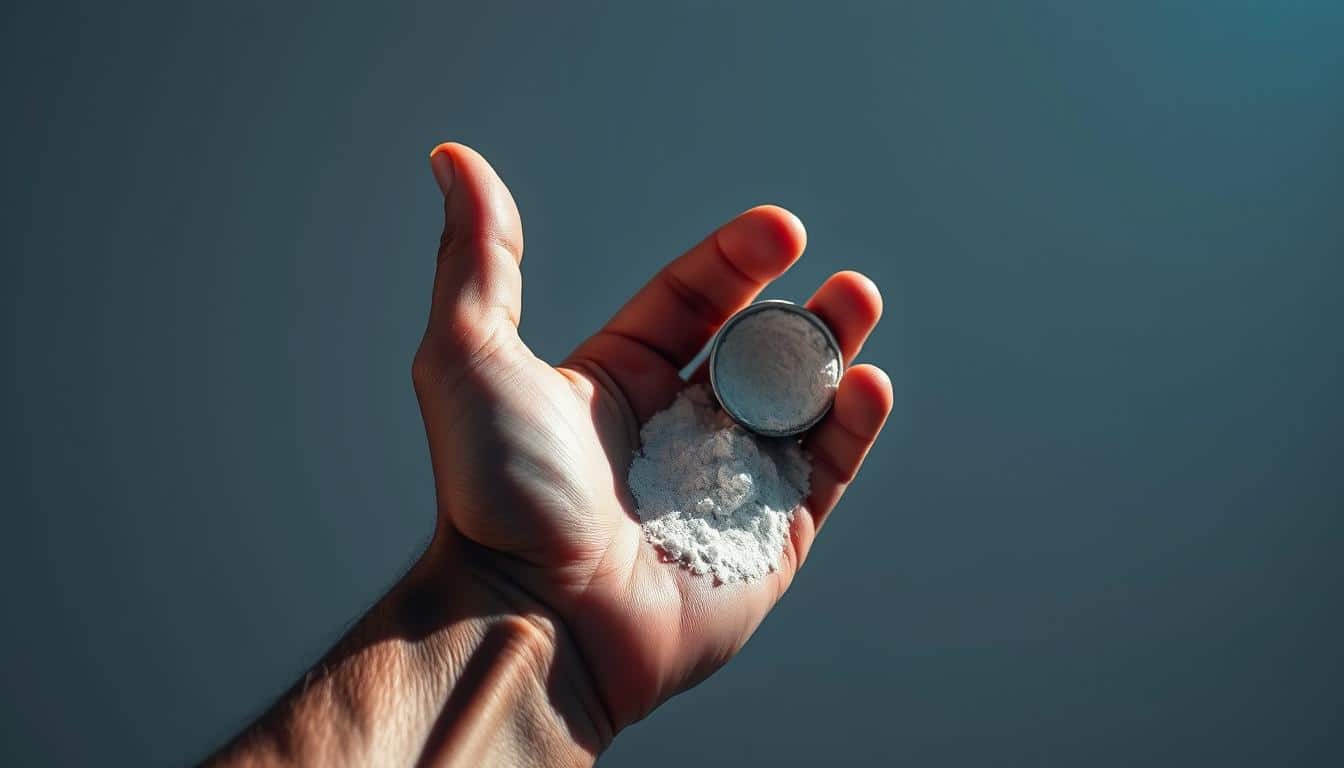I often get asked, “What is the best time to take creatine for athletes?” That question cuts straight to performance. I use clear rules so you can act today.
Research shows this supplement helps strength, power, muscle mass, and recovery. A 5 g dose peaks in 1–2 hours and stays higher for about 4 hours.
On training days, aim to be near your workout. Take a dose 60–120 minutes before, or within 60 minutes after exercise. Exercise raises blood flow to working muscle for 30–120 minutes, which helps delivery.
Some studies favor post-workout; others find no major difference. So I focus on two simple points: consistency and proximity to training. On rest days, the exact schedule matters less — daily habit matters more.
I also note loading (20–25 g daily for a few days) and maintenance (3–5 g daily) as practical steps. Pairing a dose with carbs and protein may improve uptake.
Key Takeaways
- Take the supplement close to training — within two hours before or one hour after.
- A 5 g dose peaks in 1–2 hours and stays elevated up to 4 hours.
- Exercise increases blood flow and helps delivery to working muscle.
- Studies vary on pre vs post, so prioritize consistency and timing near workouts.
- On rest days, daily consistency and maintenance dosing matter more than exact timing.
What athletes need to know about creatine timing right now
Here’s what matters right now about timing your creatine around workouts. I keep this short and practical so you can act today.
Key takeaways at a glance
- Short answer: take creatine near your session for the clearest performance gains.
- Usable window: 60–120 minutes before, or within 60 minutes after training.
- Daily consistency keeps your muscle stores topped up.

How timing connects to exercise performance
After a 5 g dose, creatine peaks in the blood in 1–2 hours and stays higher up to 4 hours.
During and after exercise, blood flow to working muscle rises for 30–120 minutes. That higher flow helps delivery of creatine to muscle cells.
Research shows both pre and post options work. The clear effect comes when doses are close to the workout rather than at random hours.
| Timing | Benefit | When to use | Notes |
|---|---|---|---|
| 60–120 min before | Peak blood levels during session | Power lifts, short sprints | Good for warm-up routines |
| Within 60 min after | Supports recovery and uptake | Heavy training days | Pair with carbs/protein |
| Rest-day dose | Maintains saturation | Any consistent daily slot | With a meal to aid uptake |
Best time to take creatine for athletes
Science gives clear clues about when around your session the supplement helps most.

Before vs after your workout: what research shows
Studies are mixed. A 2013 trial found 5 g after training gave bigger gains over four weeks.
Later trials (2014, 2015) found no clear winner. A 2022 collegiate study showed similar muscle results whether a dose was within one hour before or after when combined with whey and carbs.
Why “around your workout” beats random times of day
Your dose peaks in blood after 1–2 hours. Exercise raises blood flow for up to two hours.
That overlap helps the supplement enter muscle. Trials that paired creatine with carbs and protein near training showed better gains than dosing in the morning or evening away from sessions.
Simple timing rules you can follow today
- Pick 60–120 minutes before, or within 60 minutes after a session.
- Choose the option you will do every training day — consistency wins.
- If you train twice daily, place the dose around the main lift or sprint session.
| Window | Primary Benefit | When to use |
|---|---|---|
| 60–120 min pre | Peak levels during workout | Short, high-power sessions |
| Within 60 min post | Recovery and uptake | Heavy lifting or long sessions |
| Any day dose | Maintain saturation | Pair with a meal |
How creatine timing works with your body
A clear clock governs how your body absorbs a standard creatine dose.
After a 5 g dose of creatine monohydrate, blood levels peak in about 1–2 hours. Levels stay elevated for up to 4 hours. That creates an absorption window you can plan around.
Exercise raises blood flow to active muscles. This hyperemia lasts during training and for 30–120 minutes after. When the peak from your dose and high blood flow overlap, your muscles can draw in more creatine.
How the overlap helps muscle cells
Your muscle cells use creatine to recycle ATP. That supports short bursts and heavy reps. So the effects are most useful for high-intensity efforts within that four-hour span.
- Plan your dose so the 1–2 hour peak lines up with main working sets.
- Pairing the dose with carbs and protein can raise insulin and aid uptake.
- Over weeks, consistent dosing raises muscle stores and steady benefits follow.
| Factor | Timing | Practical tip |
|---|---|---|
| Absorption peak | 1–2 hours after 5 g | Schedule dose before main lifts or sprints |
| Elevated blood flow | During exercise + 30–120 min after | Aim for overlap with peak |
| Cell effect | Up to 4 hours of elevated levels | Best for short, intense efforts |
How to take creatine on training days
Match your supplement routine to your main working sets and you’ll improve delivery to muscle. Below I give clear, practical options you can use around a session.
Option A: 60–120 minutes before
Take 3–5 g with water and a small protein‑carb snack. A yogurt and fruit cup or a slice of toast with peanut butter work well.
Option B: Within 60 minutes after
Take 3–5 g with your post workout shake or meal. Whey and rice or a balanced plate helps uptake and recovery.
Split dosing around the session
If one full dose upsets your stomach, split it. Try 2–3 g before and 2–3 g after. This still lines a blood peak with exercise and keeps muscle stores rising.
Pre-, intra-, and post-workout examples
- Pre: 4 g + yogurt and banana, 90 minutes before heavy sets.
- Intra: 1–2 g mixed in a drink during long sessions.
- Post: 4 g with whey, carbs, and extra water to aid performance and digestion.
| Option | Dose | Quick tip |
|---|---|---|
| Pre 60–120 min | 3–5 g | Use a protein‑carb snack |
| Post within 60 min | 3–5 g | Mix with shake or meal |
| Split | 2–3 g + 2–3 g | Gentler on the stomach |
Hydration note: drink extra water with the dose. That cuts nausea and supports performance during exercise.
How to take creatine on rest days
Rest days are not a break for supplements — they’re where steady dosing pays off. The aim is simple: maintain muscle creatine levels so exercise performance stays ready on your next session.
Consistency and maintenance dosing
Keep a daily habit. Aim for 3–5 g once per day on rest days. That single dose preserves saturation and supports future exercise sessions.
Why taking it with a meal can help
Take your dose with lunch or dinner that includes carbs and protein. That pairing can raise insulin and aid uptake into muscle.
- Pick the same meal each day so you don’t forget.
- Use a phone reminder labeled “rest days creatine” and check it off.
- Traveling? Pack single‑serve sachets and a bottle of water for easy dosing.
- Don’t skip the day dose just because you rested—steady levels matter more than exact time.
| Goal | Dose | Practical tip |
|---|---|---|
| Maintain saturation | 3–5 g once daily | With lunch or dinner that has protein and carbs |
| Simple routine | 3–5 g | Same meal each day + phone reminder |
| On the move | 3–5 g | Single‑serve packs and bottled water |
If you want ideas on complementary supplementation and meals around training blocks, see a short guide on top supplements for performance. I keep this routine compact so you never miss a day and your muscle stores stay topped up.
Dosing guide: loading phase and daily maintenance
Let’s map a simple dosing plan that matches your training schedule and goals.
Loading block
Use 20–25 g per day of creatine monohydrate for 5–7 days. Split this into 4–5 servings of 5 g each.
Sample day: 5 g with breakfast, lunch, mid-afternoon, dinner, and one before bed.
Daily maintenance
After loading, take 3–5 g per day to keep muscle stores full. One dose with a meal is easy and reliable.
Skip-loading option
If you skip loading, take 3–5 g per day. Research shows 3 g per day for about 28 days reaches similar saturation as a short loading block. The steady path is slower but effective.
- If you need faster gains for a meet block, use the loading phase.
- If steadier habits suit you, use daily maintenance and pair with meals.
- Keep a small scoop in the tub and set a phone reminder for compliance.
| Plan | Daily dose | Duration | When to use |
|---|---|---|---|
| Loading | 20–25 g (5 g x 4–5) | 5–7 days | Fast saturation before a training block |
| Maintenance | 3–5 g | Ongoing | Keep stores high with one daily dose |
| No load | 3–5 g | 3–4 weeks to saturate | Slow, steady approach |
Creatine with food, protein, carbs, caffeine, and water
What you eat and drink with a dose can change how well muscle cells pull creatine into storage.
Pair with protein and carbs. I take 3–5 g with 20–40 g protein plus a carb source. That combo raises insulin and helps cells pull more creatine into muscle.
Practical meal ideas
- Steak with sweet potato — solid protein and carbs.
- Tofu stir‑fry over rice — plant protein and starch.
- Tuna sandwich plus banana smoothie — quick and portable.
Caffeine considerations
Current reviews show coffee or caffeine does not meaningfully block creatine effects. Your pre‑workout coffee is fine.
Hydration: how much water to aim for
Drink an extra 8–16 oz of water with the dose. Keep your daily hydration plan on track so digestion and tolerance stay good.
| Goal | Action | Why it works |
|---|---|---|
| Uptake | 3–5 g + 20–40 g protein + carbs | Carbs raise insulin; cells absorb more |
| Tolerance | Split dose if needed (2–3 g + 2–3 g) | Eases stomach issues |
| Product choice | Simple monohydrate with third‑party testing | Proven quality and minimal extras |
Quick routine: mix a creatine supplement into a whey shake for a one‑minute habit that covers food, fluid, and supplementation.
Safety, side effects, and who should avoid creatine
Let’s cover the practical safety checks every athlete should know. I keep this clear and action‑oriented so you can use the supplement responsibly.
Common side effects and how to reduce them
Most healthy adults tolerate creatine well. Some people report stomach upset, diarrhea, or muscle cramping.
Simple fixes: take smaller servings with meals, sip extra water, or split a dose into two smaller portions. Avoid large single loads on an empty stomach.
Medical conditions and when to talk to your doctor
Creatine can raise certain kidney-related lab markers without harming kidney function in healthy users. Still, anyone with kidney or liver problems should consult a doctor before using any supplement.
If you have chronic health issues, are on medication, or are pregnant, get medical advice first.
- Pick creatine supplements with NSF or another third‑party quality mark.
- Stick to 3–5 g per day after any loading phase—more is not better.
- Creatine is allowed in most sports, but use a tested product to avoid banned contaminants.
- Research supports safety in healthy adults using standard doses.
| Concern | What to watch | Practical action | Why it matters |
|---|---|---|---|
| Stomach upset | Diarrhea, nausea | Split dose; take with food and water | Improves tolerance and training comfort |
| Muscle cramp | Occasional cramping | Check hydration and electrolytes | Maintains muscle function during sports |
| Lab markers | Raised creatinine on tests | Inform your doctor and interpret results in context | Avoids unnecessary alarm over benign changes |
| Product safety | Unregulated market | Choose NSF/third‑party tested supplements | Reduces risk of contamination and banned substances |
Sample week: training and rest day timing plans
I’ll map a practical week so you can slot your dose around real sessions. Use the plan as a template and tweak it for your schedule.
Strength-focused week
Mon, Wed, Fri — lifting at 5 pm. I take creatine at 3:30–4:00 pm with a protein‑carb snack (yogurt + fruit).
On Friday I switch: I take creatine within 60 minutes after the workout with dinner to support recovery.
Tue and Thu are rest days. I take 3–5 g at lunch to keep muscle stores steady.
Saturday: HIIT at 10 am. I take creatine at 9 am with granola and yogurt for quick energy.
Mixed training week (HIIT and lifting)
Plan around the session with the heaviest sets. If I train twice, I place the dose near the main lift and do not add extra doses that day.
I pack single‑serve sachets when travel moves a workout. That protects performance and keeps recovery consistent.
| Day | Session | Dose timing | Meal tip |
|---|---|---|---|
| Mon/Wed | Strength (5 pm) | 3:30–4:00 pm | Yogurt + banana |
| Fri | Strength (5 pm) | Within 60 min post | Dinner with protein |
| Sat | HIIT (10 am) | 9:00 am pre | Granola + yogurt |
| Tue/Thu | Rest day | Lunch | Meal with carbs & protein |
Conclusion
Keep it simple: place your daily dose near the session that matters most. I prefer one clear rule that beats confusion in articles and study summaries.
Choose one of two windows: 60–120 minutes before, or within 60 minutes after your workout. Take 3–5 g of creatine monohydrate each day, and keep that same habit on rest days.
Pair a scoop with a protein + carb meal and add 8–16 oz of water. That overlap of peak blood levels and higher blood flow during exercise helps uptake and supports performance and muscle benefits over weeks.
Research is mixed on pre vs post, so focus on consistency. My single action plan: start taking creatine every day, place it around training, and keep working hard for steady results.


